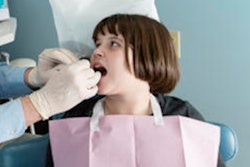
More often than not, state Medicaid programs will pay for oral healthcare provided by nondental primary care providers, and North Carolina is no exception. The Into the Mouths of Babes program began in 2000 and is backed by state Medicaid.
In the program, trained primary care providers, including physicians, physician assistants, and nurse practitioners, provide fluoride varnish, oral health counseling, screening, and risk assessments for children younger than age 3.5 and refer them to local dentists if caries are suspected.
Now researchers from several departments at the University of North Carolina at Chapel Hill and the Veterans Affairs (VA) medical center in Durham have gauged the program's success in a new study published in the Journal of Dental Research (July 2014, Vol. 93:7, pp. 633-638). Their results suggest that primary care providers should actively take part in the maintenance of oral health for their youngest patients instead of leaving it entirely in the hands of dentists.
Preventive oral health services provided by primary care providers (PCPs) may lead to greater reduction in caries-related treatments (CRTs) than dentist visits alone, because of children's increased opportunity to receive multiple visits in medical offices during well-child visits, the researchers wrote. "This study supports guidelines and reimbursement policies that allow preventive dental visits based on individual needs." The data suggest that children who saw only primary care providers have fewer caries-related treatments and pay less for treatment at ages 3 through 5.
The authors were interested in learning about the impact of the program on Medicaid claims for caries-related treatments, since they found that previous studies on the topic did not control for preventive services received from dentists nor did they examine whether primary care provider visits reduced caries-related treatments to the same extent as dentists visits. Consequently, based on North Carolina Medicaid claims, the researchers sought to find out if the provider of preventive oral health services (primary care provider, dentist, or both) is associated with the annual number of caries-related treatments and payments for children age 3 to 5, the age after which children are ineligible for these benefits.
The retrospective study pulled data from Medicaid enrollment and claims files from 2000 to 2006 and included 93,986 child-year observations for, after exclusions, 41,453 children from age 3 to 5. The researchers excluded 112,760 children from the study because they had no oral health visits before they reached age 3. The included children had at least one visit by that point to a primary care provider, dentist, or both. The children came from a variety of backgrounds, rural and urban, and with or without access to fluoridated water, for example.
Caries-related treatments and total payments for the treatments, which were identified by Current Dental Terminology codes and adjusted to account for inflation, were sorted based on the child's age of 3, 4, or 5 and totaled. Medicaid covers up to six visits per child until age 3.
“PCP visits were associated with fewer CRT and lower payments than dentist visits.”
In their analysis, the researchers determined that preventive oral healthcare was provided by a dentist to roughly 28% of the included children, 4,196 of whom saw only a dentist, while 7,615 saw both a dentist and primary care provider. The remaining 72% received preventive care from a primary care provider, and, of them, 16% saw a primary care provider four or more times.
The researchers also found that the 33% of children received caries-related treatments between ages 3 and 5, and children were more likely to have caries treatments if they had early preventive dentist visits. Additionally, they found significant disparities in treatments and payments between children who saw dentists, primary care providers, or both prior to their third birthday, according to the researchers' analysis of variance.
- Saw only PCP: CRT = 0.87 ± 2.96; payment = $172 ± $1,865
- Saw only dentist: CRT = 1.48 ± 3.17; payment = $234 ± $853
- Saw both PCP and dentist: CRT = 1.52 ± 3.48; payment = $273 ± $1,018
The researchers found other results unfavorable to dentists or dentists combined with primary care providers when they considered the expected number of caries-related treatments: More mean treatments were anticipated for children at ages 3 and 4 who saw only dentists or both dentists and primary care providers than those who only saw primary providers. But the anticipated treatment trends after age 3 went in different directions for dentists and the combination of providers compared with primary care provider visits only:
- Dentist only: 1.78 at age 3 to 1.09 at age 5
- Both: 1.84 at age 3 to 1.12 at age 5
- PCP only: 0.74 at age 3 to 0.95 at age 5
Interestingly, the researchers noted a 39% decrease in the average expected annual number of caries treatments for children from age 3 to 5 who saw only dentists.
They found significant disparities in the annual average expected caries-related treatment payments as well, which were similarly unfavorable to dentists and most favorable to primary care providers. Children who saw primary providers had the lowest anticipated treatment payments at ages 3, 4, and 5. However, a familiar payment pattern arose when comparing the types of healthcare providers these children visited.
- PCP only: Age 3 = $132, age 4 = $157, age 5 = $148
- Both: Age 3 = $301, age 5 = $173
- Dentist only: Age 3 = $282, age 5 $166
The researchers explained that the anticipated payment amounts for the latter two groups at age 4 were not significantly different from one another.
Contrary to their hypothesis, "children who had only PCP visits before their third birthday received fewer CRT and had lower CRT payments on average than children who received preventive services from dentists," the researchers wrote. They suggested that primary care providers' opportunity to provide fluoride varnish earlier on younger teeth and access to dentists could have impacted their results. Indeed, part of the Into the Mouths of Babes program's purpose was to provide greater oral care in light of dentist workforce shortages and low rates of Medicaid acceptance among dentists.
As predicted, caries-related treatment payments were higher in the group that visited both primary care providers and dentists, which the researchers attributed to referrals. "Notably, 99% of children with both dentist and PCP visits first visited a PCP," they explained. This fits American Academy of Pediatrics recommendations.
"PCP visits were associated with fewer CRT and lower payments than dentist visits," the researchers concluded. "PCP visits provide more opportunities to reduce CRT than dentist visits due to the current reimbursement model and children's increased likelihood of visiting medical offices."



















